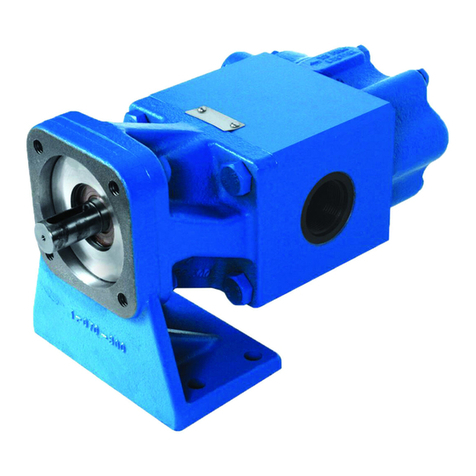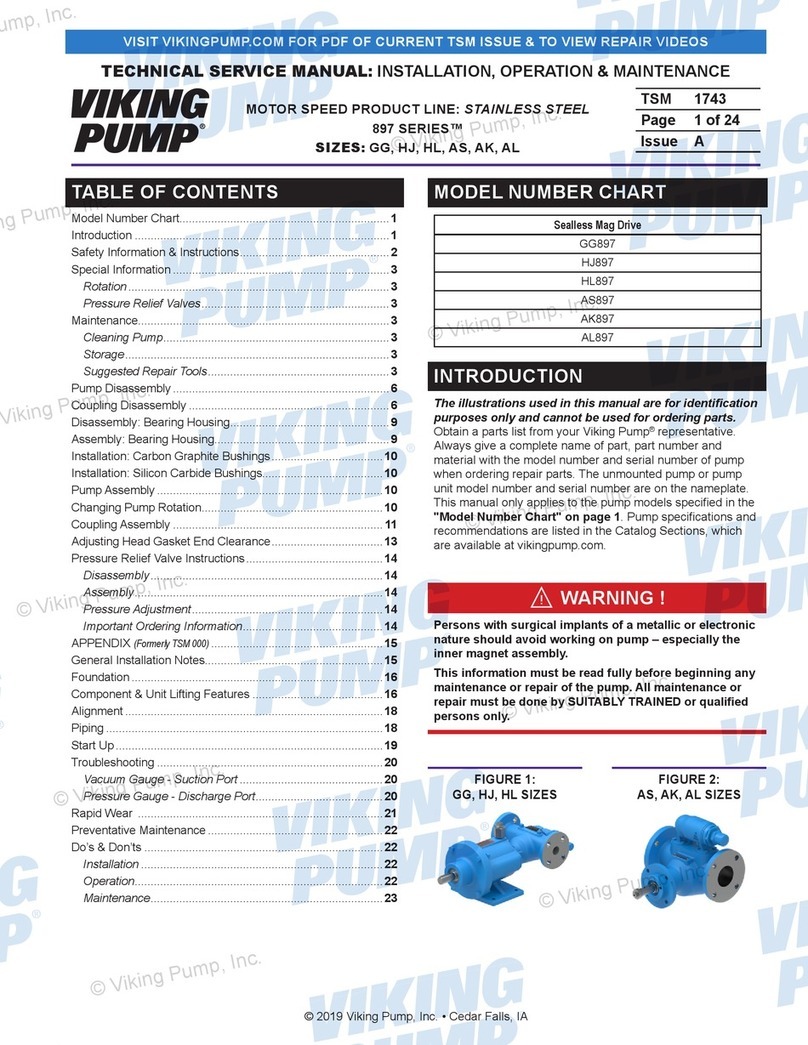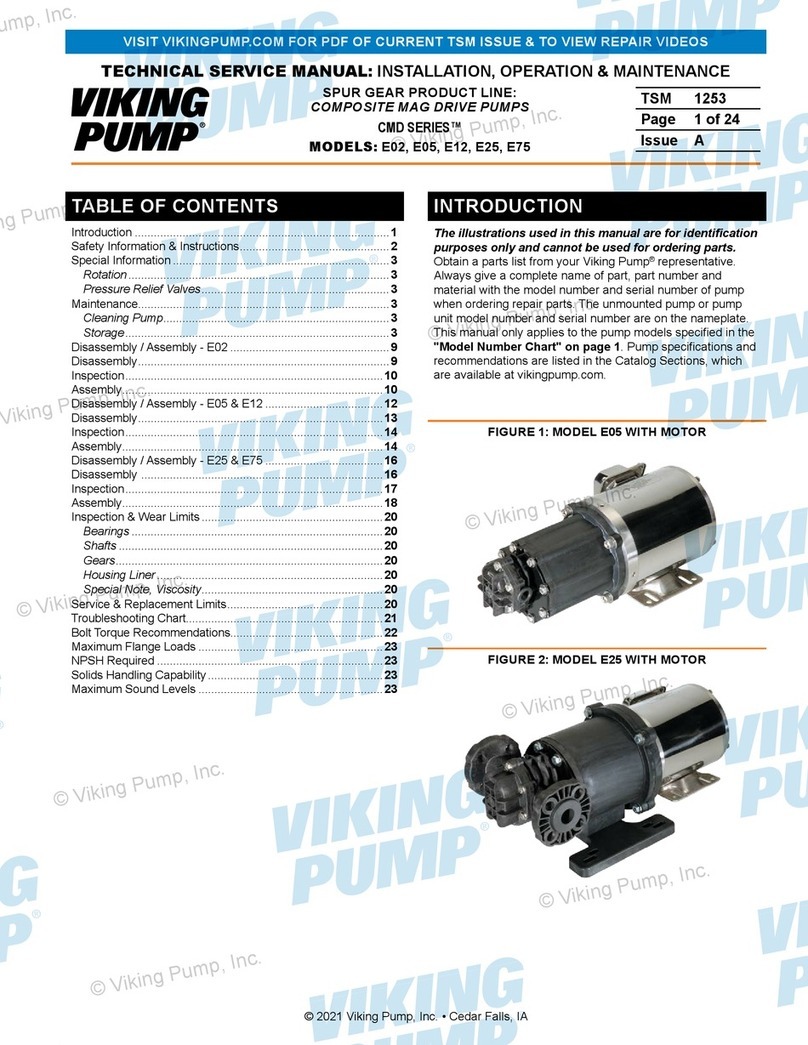
SECTION TSM 340.3 ISSUE A PAGE 4 OF 8
5. A pressure relief valve is required in the discharge line.
See “Installation, General”.
6. The pump must not be used to support the piping.
Hangers, supports, stands, etc. must carry the weight of
the pipes.
7. When fastening piping to the pump do not impose any
strain on the pump casing.
“Springing” or “drawing” the piping up to the pump will
cause distortion, possible misalignment and probable
rapid wear of the pump. Do not use the pump to correct
errors in piping layout or assembly.
8. All joints of piping system must be tight. Loose joints
result in liquid leaks or suction side leaks. Air leaks make
the pump noisy and reduce flow.
9. Drive alignment must be checked after piping has been
connected to the pump.
10.Provide a pressure relief device in any part of a pump
and piping system that can be valved off and, thus,
completely isolated. A rise in temperature will cause a
liquid to expand. If there is no provision for pressure
relief in the closed off section, there is a chance that the
pump or piping will rupture.
DANGER!
Before starting the pump, be sure all drive
equipment guards are in place.
Failure to properly mount guards may result in
serious injury or death.
START UP:
Before pushing “start” button, check the following:
1. Vacuum and pressure gauges (liquid filled) are mounted
on or near the pump. Gauges are the quickest and most
accurate way of finding out what is happening in the pump.
2. Pump is correctly aligned using good laser alignment
equipment.
3. There is no pipe strain on the pump casing.
4. Rotate the pump shaft by hand to be sure it turns freely.
5. Motor has been jogged and is running in the correct
direction. Refer to “Installation, General” on page 3.
6. Pressure relief valve is installed properly in the system.
7. Suction piping is connected and tight, and valves are open.
8. Make sure the discharge piping is properly connected
and sealed, valves are open, and there is a place for the
liquid to go.
9. Make sure all guards are in place.
10.The above checklist is a general guideline to be used
prior to starting the pump. Since Viking Pump cannot
foresee every application for our product and possible
system design, the final responsibility is with the
user. The pump must be utilized within the catalog
specifications and the pump system must be designed to
provide safe working conditions.
PRESSURE RELIEF VALVES:
Viking pumps are positive placement pumps and must be
provided with some sort of pressure protection. This may be
an inline pressure relief valve, a torque limiting device or a
rupture disk.
For additional information on pressure relief valves, refer to
Technical Service Manual TSM000 and Engineering Service
Bulletin ESB-31.
MOUNTING:
1. Surfaces pump mounts against must be clean and flat.
2. For NEMA Mount, use SAE Grade 5 or better capscrews
to mount pump.
3. Standard GP Series pumps are designed to be used with
spacer type couplings that do not induce axial thrust on
the pump shaft. If an improper type of coupling is used,
internal damage may result.
4. Do not strike or press the pump drive coupling to install.
Internal pump damage will result. If the coupling does
not slide onto the shaft, inspect the coupling, shaft and
key for nicks or burrs and remove.
5. Once the pump has been mounted and the coupling
installed, it is recommended to put lube oil into the suction
port and turn the pump by hand to make sure it turns freely.
ALIGNMENT:
Check alignment after mounting.
1. If unit has flexible coupling, remove any coupling guards
or covers and check alignment of coupling halves using
good laser alignment equipment.
Viking recommends an offset misalignment of .0025”
or better and an angular misalignment of .003”/10”
or better. Consult coupling manufacturer’s alignment
requirements for acceptability.
2. Make final check on alignment after all piping
connections have been made.
PIPING/HOSE:
The cause of many pumping problems can be traced to
suction piping. It should always be as large in diameter and
as short in length as possible.
Before starting layout and installation of your piping system,
consider the following points:
1. Never use piping smaller than pump port connections.
Piping larger in diameter than the port connection is
sometimes required to reduce suction losses.
2. Be sure the inside of pipe is clean before installing.
3. When approaching an obstacle to the suction line, go
around instead of over it. Going over an obstacle can
create an air pocket. Where practical, slope the piping so
no air or liquid pockets will be formed. Air pockets in the
suction line make it hard for the pump to prime.
4. A strainer on the suction side of the pump should always
be considered in any pumping system. The strainer will
keep foreign matter from entering the pump. The strainer
mesh or perforation size should be large enough so
that it does not cause excessive pressure drop, but fine
enough to protect the pump.
Use of a strainer is particularly important at start up to
help clean the system of weld beads, pipe scale and
other foreign objects.

















































